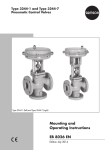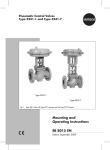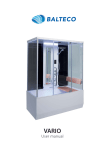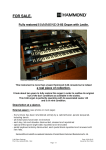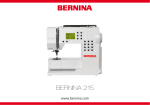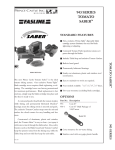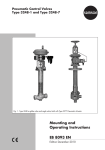Download Mounting and Operating Instructions EB 8097 EN
Transcript
Type 3347-1 and Type 3347-7 Pneumatic Control Valves Hollow-mold cast body with welding ends Bar stock body with threaded connections Fig. 1 · Type 3347-7 Control Valve with Type 3277 Actuator and integral positioner Mounting and Operating Instructions EB 8097 EN Edition June 2004 Contents Contents Page 1 Design and principle of operation. . . . . . . . . . . . . . . . . . . . 4 2 2.1 2.2 2.3 Assembling valve and actuator. . . . . . . . . . . Assembly and adjustment . . . . . . . . . . . . . Option to pretension the springs for actuator version "Actuator stem extends" . . . . . . . . . . . . . . Valve and actuator that have different rated travels. 3 3.1 3.2 Installation . . . . . . . . . . . . . . . . . . . . . . . . . . . . . . . 7 Mounting position. . . . . . . . . . . . . . . . . . . . . . . . . . . . 7 Signal pressure line . . . . . . . . . . . . . . . . . . . . . . . . . . . 8 4 Operation . . . . . . . . . . . . . . . . . . . . . . . . . . . . . . . 8 5 5.1 Maintenance . . . . . . . . . . . . . . . . . . . . . . . . . . . . . . 8 Replacing sealing parts or the plug . . . . . . . . . . . . . . . . . . . 9 6 Description of nameplates . . . . . . . . . . . . . . . . . . . . . . . 10 7 Customer inquiries . . . . . . . . . . . . . . . . . . . . . . . . . . 11 . . . . . . . . . . . 6 . . . . . . . . . . . 6 . . . . . . . . . . . 7 . . . . . . . . . . . 7 Note: Non-electrical actuators and valves do not have their own potential ignition source according to the risk assessment in the rare incident of an operating fault, corresponding to EN 13463-1: 2001 paragraph 5.2, and therefore do not fall within the scope of the European Directive 94/9/EC. Refer to paragraph 6.3 of EN 60079-14:1977 VDE 0165 Part 1 concerning connection to equipotential bonding system. 2 EB 8097 EN Safety instructions General safety instructions 4 The control valve may only be mounted, started up or serviced by fully 4 4 4 trained and qualified personnel, observing the accepted industry codes and practices. Make sure employees or third persons are not exposed to any danger. All safety instructions and warnings in these mounting and operating instructions, particularly those concerning assembly, start-up and maintenance, must be observed. The control valves fulfill the requirements of the European Pressure Equipment Directive 97/23/EC. Valves with a CE marking have a declaration of conformity that includes information about the applied conformity assessment procedure. The corresponding declaration of conformity can be viewed and downloaded on the Internet at http://www.samson.de. For appropriate operation, make sure that the control valve is only used in areas where the operating pressure and temperatures do not exceed the operating values which are based on the valve sizing data submitted in the order. The manufacturer does not assume any responsibility for damage caused by external forces or any other external influence! Any hazards which could be caused in the control valve by the process medium, operating pressure, signal pressure or by moving parts are to be prevented by means of the appropriate measures. Proper shipping and appropriate storage of the control valve are assumed. CAUTION! 4 For installation and maintenance work on the valve, make sure the relevant 4 4 section of the pipeline is depressurized and, depending on the process medium, drained as well. If necessary, allow the control valve to cool down or warm up to reach ambient temperature prior to starting any work on the valve. Prior to performing any work on the valve, make sure the supply air and control signal are disconnected or blocked to prevent any hazards that could be caused by moving parts. Special care is needed for pneumatic control valves when the actuator springs are pretensioned. These actuators are labeled correspondingly and can also be identified by three long bolts protruding from the bottom of the actuator. Prior to starting any work on the control valve, relieve the compression from the pretensioned springs. EB 8097 EN 3 Design and principle of operation 1 Design and principle of opera- Fail-safe position tion Depending on how the springs (8.3) are ar- The Type 3347 Angle Valve can be combined with either a Type 3271 or a Type 3277 Pneumatic Actuator with integral positioner attachment. The standard valve body is designed for welding in pipelines. Further versions with threaded, flange or clamp connections are available as options. The valve body and bonnet are connected by an easy-to-use clamp. The body is designed free of cavities, making it suitable for cleaning-in-place (CIP) procedures. The control valves are primarily intended for throttling or on-off service in the food processing industry. The process medium flows through the valve in the direction indicated by the arrow. The position of the plug (3) is determined by changes in the signal pressure acting on the actuator diaphragm. The stem connector (7) connects the plug stem (6) with attached plug (3) and actuator stem (8.1). The stems are sealed by PTFE seals (5.1 and 5.3). In the special version with connection to a steam line, an additional spring-loaded PTFE ring packing (4.2) is used to seal the valve. The steam line connection can be used to clean the plug stem. 4 EB 8097 EN ranged in the actuator, the control valve assumes two different fail-safe positions: Actuator stem extends When the pressure is relieved or the supply air fails, the actuator springs move the actuator stem downwards and close the valve. The valve is opened against the force of the springs when the signal pressure increases. Actuator stem retracts When the pressure is relieved or the supply air fails, the actuator springs move the actuator stem upwards and open the valve. The valve is closed against the force of the springs when the signal pressure increases. Design and principle of operation Type 3271 Actuator Type 3277 Actuator 8.3 8 8.2 8.1 6.1 6.2 7 5.5 5.3 8.1 5 8.2 6 5.4 5 5.2 1.3 3 1 1 1.1 1.2 1.3 3 4.1 4.2 4.3 5 5.1 5.2 5.3 5.4 9 8 Valve body Centering ring Body gasket Compensation ring Plug Spring (spec. version) Packing (spec. version) Washers (spec. version) Valve bonnet Stem seal Body and stem seal Wiper Clamp 5.5 Travel indicator scale 6 Plug stem 6.1 Stem connector nut 6.2 Lock nut 7 Stem connector 8 Actuator 8.1 Actuator stem 8.2 Annular nut 8.3 Compression springs 9 Loading pressure connection 10 Compression screw fitting Special version with connection to a steam line Version with hollow-mold cast body 10 4.2 5.1 5.4 1.2 1.1 6.2 6 5.3 4.3 4.1 4.3 3 1 Fig. 2 · Sectional drawings EB 8097 EN 5 Assembling valve and actuator 2 Assembling valve and actuator Instead of the simple pneumatic actuator, it is also possible to attach an actuator with additional handwheel or an electric actuator. The standard pneumatic actuator can be replaced by a pneumatic actuator in a different size. If the travel range of the actuator exceeds that of the valve in the valve-actuator configuration, the manufacturer will adjust the spring assembly of the actuator such that the travels match. 2.1 Assembly and adjustment If the valve and actuator have not been preassembled by the manufacturer or in the case that the original actuator attached to the valve is to be replaced by another actuator of a different type or size, proceed as follows: 1. Loosen the lock nut (6.2) and stem connector nut (6.1) on the valve. Firmly press the plug with the plug stem into the seat. Then thread down the lock nut and stem connector nut. 2. Remove clamps of the stem connector (7) and annular nut (8.2) on the actuator (8). Slide the annular nut over the plug stem. 3. Place the actuator on the valve bonnet (5) and screw tight using the annular nut (8.2). 4. Read the nameplate on the actuator to determine which bench range (e.g. 0.2 to 1 bar or 0.4 to 2 bar) and which op- 6 EB 8097 EN erating mode (e.g. "Actuator stem extends") are used. The operating mode (fail-safe action) "Actuator stem extends" or "Actuator stem retracts" is indicated on the nameplate by FA or FE on the Type 3271 Actuator and by the appropriate symbol on the Type 3277 Actuator. The lower bench range corresponds to the lower signal pressure range to be adjusted; the upper bench range corresponds to the upper signal pressure range. Note: Make sure on assembling the valve that the stem seal (5.1) does not get damaged. The maximum possible travel of the actuator may not exceed the maximum permissible valve travel (see adhesive label on the yoke). 5. For actuators with fail-safe action "Actuator stem extends", apply the pressure corresponding to the lower signal pressure range (e.g. 0.2 or 0.4 bar) to the loading pressure connection on the bottom diaphragm chamber. For actuators with fail-safe action "Actuator stem retracts", apply the pressure corresponding to the upper signal pressure range (e.g. 1 or 2 bar) to the loading pressure connection on the top diaphragm chamber. 6. Manually turn the stem connector nut (6.1) until it touches the actuator stem (8.1) and then turn it a further 1/4 turn. Screw tight the lock nut. Installation 7. Position clamps of the stem connector (7) and fasten. Align travel indicator scale (5.3) with tip of the stem connector; for actuators with "Actuator stem extends" align it with lower marking (valve closed) and for actuators with "Actuator stem retracts" align it with top marking (valve open). Note concerning dismantling the actuator: On dismantling an actuator with "Actuator stem extends" and especially when an actuator has pretensioned springs, first apply pressure slightly higher than the lower bench range value (see nameplate on actuator) to the loading pressure connection on the bottom diaphragm chamber before loosening the annular nut (8.2). 2.2 Option to pretension the springs for actuator version "Actuator stem extends" To achieve a greater thrust, the springs of actuators (350 and 700 cm2) can be pretensioned by up to 25 % of their travel or their bench range. Example: If, with a bench range of 0.2 to 1 bar, the springs are to be pretensioned by 0.1 bar, for example, the bench range is shifted by 0.1 bar, resulting in a new bench range of 0.3 to 1.1 bar (0.1 bar corresponds to a compression of 12.5 %). When adjusting the valve, a signal pressure of 0.3 bar is to be set as the lower signal pressure range. The new bench range of 0.3 to 1.1 bar must be marked on the nameplate as bench range with pretensioned springs. 2.3 Valve and actuator that have different rated travels Note: Valves that have a smaller travel than that of the actuator must always use pretensioned springs. CAUTION! Actuators with springs that have already been pretensioned by the manufacturer without attachment to a valve are marked by an appropriate label. In addition, such actuators can be identified by three bolts and nuts protruding from the bottom diaphragm case. 3 Installation 3.1 Mounting position The valve must be installed upright with the actuator on top. Note: Remove the clamp (5.4) first and take the entire bonnet assembly off the valve body before welding (valve version with welding ends) in the pipeline. Note: Always install the valve free of stress. Check that the plug stem moves smoothly. Thoroughly flush out the pipeline before installing the valve. EB 8097 EN 7 Operation If the valve bonnet is designed with a connection for a steam line, connect the compression screw fittings to the steam supply line. CAUTION! A higher pressure in the steam line (steam or sterile fluid) than the pressure in the valve itself can affect the process medium in the valve as it may become mixed with the steam (or sterile fluid). Observe the relevant hygiene regulations. 3.2 Signal pressure line Connect the signal pressure line for valves with actuator version "Actuator stem extends" to the loading pressure connection on the bottom diaphragm case, and for valves with actuators "Actuator stem retracts" to the loading pressure connection on the top diaphragm case. The lower connection of Type 3277 Actuator is located on the yoke of the bottom diaphragm case. 4 Operation (e.g. reversing the direction of action, etc.) For details, refer to the Mounting and Operating Instructions of the respective pneumatic actuator. EB 8310 EN for Type 3271 and EB 8311 EN for Type 3277. 8 EB 8097 EN 5 Maintenance If leakage occurs, this could be caused by a damaged wiper (5.3) or stem seal (5.1) or the PTFE V-ring packing (4.2) is defective in the version with connection to a steam line. If the valve does not seal properly, the tight shut-off may be impeded by dirt or other impurities caught between the seat and plug, or by damaged seat joints. Remove the parts, clean them thoroughly and replace them with new ones, if necessary. Before servicing or disassembling the control valve, depressurize the concerned section of the plant and drain it. Wait until the medium has cooled down, if necessary. As valves are not free of cavities, there might still be residual medium in the valve. We recommend removing the valve from the pipeline or remove the entire valve assembly when the valve is welded in the pipeline. On performing any work on the valve body, first shut off the supply pressure, disconnect the supply pressure line and remove the actuator. On disassembling or assembling the valve, make sure that the stem seal does not get damaged. Do not move the plug beyond the permissible valve travel. Maintenance 5.1 Replacing sealing parts or the plug Note: Prior to performing any work on the valve body, remove the actuator first. 1. Apply pressure higher than the lower bench range (see nameplate) to the actuator. 2. Remove clamps of the stem connector (7) between actuator stem and plug stem and unscrew annular nut (8.2). 3. Lift the actuator off the valve. 4. Remove nuts (6.1 and 6.2). 5. Take off the clamp (5.4) and remove carefully the valve bonnet (5) together with plug (3) and centering ring (1.1). 6. Pull plug out of the valve bonnet, taking particular care to prevent the stem seal (5.1) from getting damaged. 7. Push out damaged parts such as wiper (5.3) and stem seal (5.1) using an appropriate tool. In the version with connection to a steam line, additionally take out packing (4.2), packing washers (4.3) and spring (4.1). Clean the packing chamber. 8. Check that the surface of the plug stem is highly polished and free of score marks. If the stem surface is not flawless, it must be repolished to ensure that the stem seal cannot get damaged. 9. Apply a special lubricant to each new part and the plug stem. Contact your nearest SAMSON subsidiary or the SAMSON After-sales Service department for information on suitable lubricants. 10. Put the stem seal over the plug stem at first in the opposite direction with lip towards the threaded end to stretch the lip of the stem seal slightly. Carefully pull off the stem seal again. 11. Slide a new centering ring (1.1) with gasket (1.2) over the plug stem (not necessary with bar stock body version). 12. Carefully slide the stem seal, centering it over the threaded end of the plug stem. The stem seal must fit tightly, but slide easily over the plug stem. 13. Insert the plug stem with stem seal and centering ring (1.1), if applicable, into the valve bonnet. Slide the wiper (5.3) over the plug stem into the valve bonnet. 14. Carefully place the valve bonnet onto the valve body. Carefully lubricate the clamp (5.4) as well as the flange of the valve bonnet and valve body. 15. Place the clamp (5.4) in position and screw tight the clamp screw. Hit the clamp lightly with a plastic hammer and tighten the clamp screw again. Repeat this procedure several times to tighten the clamp as far as it will go and a leakproof body is achieved. If, in the version with a steam line connection, the valve bonnet is too light to put the clamp back on, first slightly press the packing springs together using the valve bonnet. EB 8097 EN 9 Description of nameplates 16. Thread the lock nut (6.2) and nut (6.1) onto the plug stem (6). 17. Mount actuator and adjust the lower or upper bench range as described in section 2. 6 Description of nameplates 2 1 3 0062 DN 4 10 SAMSON 3347 Made in France Valve labeling, laser printed 5 Pmax20˚C= KVS 8 6 Tmax= 7 Serial-No. 9 Nameplate of Type 3271 Actuator SAMSON H 5 F 1 6 2 3 V 4 7 1 2 3 4 5 6 7 8 Type designation with modification index FDA compliance, if applicable PED conformity, if applicable Nominal size Body material Maximum pressure (bar or psi) Maximum operating temperature (°C or °F) Flow coefficient acc. to DIN or ANSI, % = equal percentage, Lin = linear 9 Serial number 10 Year of manufacture Nameplate of Type 3277 Actuator SAMSON Model - No. 1 Serial - No. 1 2 3 4 5 6 7 Type designation Modification index Effective diaphragm area Operating mode: For Type 3271: FA Actuator stem extends FE Actuator stem retracts For Type 3277: Left: Actuator stem extends Right: Actuator stem retracts Travel Bench range (spring range) Bench range with pretensioned springs Fig. 3 · Nameplates 10 EB 8097 EN Pneum. Stellantrieb 3 Pneum. actuator Servo - monteur pneum. Federbereich Spring range Plage des ressorts Stelldruckbereich Signal pressure range Plage avec précontrainte Hub cm² Stroke Course mm bar bar Zuluft max. 6 bar Begrenzt auf Air supply 90 psi Up to Air d' alimentation Limité à Made in France bar Customer inquiries 7 Customer inquiries Please submit the following details: 4 Type designation and serial number 4 Nominal size and version of the valve 4 Pressure and temperature of the process medium 4 Flow rate in m³/h 4 Bench range of the actuator (e.g. 0.2 to 1 bar) 4 Installation drawing Dimensions Refer to the Data Sheet T 8097 EN for the dimensions and weights of the various valve versions. EB 8097 EN 11 EB 8097 EN S/Z 2014-07 SAMSON AG ⋅ MESS- UND REGELTECHNIK Weismüllerstraße 3 ⋅ 60314 Frankfurt am Main, Germany Phone +49 69 4009-0 ⋅ Fax +49 69 4009-1507 Internet: http://www.samson.de












